| |
Early restoration of mucosal CD4 memory CCR5 T cells in the gut of SIV-infected rhesus predicts long term non-progression
|
| |
| |
AIDS:Volume 21(18)30 November 2007p 2377-2385
Ling, Binhuaa,b; Veazey, Ronald Sa,b; Hart, Mikea; Lackner, Andrew Aa,b; Kuroda, Marceloa,b; Pahar, Bapia,b; Marx, Preston Aa,c
From the aTulane National Primate Research Center, Covington, Louisianna, USA
bTulane University School of Medicine, New Orleans, Louisianna, USA
cTulane University School of Public Health and Tropical Medicine, New Orleans,Louisianna, USA.
Abstract
Objectives: To use SIVmac-infected Chinese-origin rhesus macaques (Ch Rh) to characterize the immunopathology of the long term non-progressor (LTNP) state. The key questions addressed were whether or not LTNP experience an early and rapid loss of mucosal CD4 T cells during the acute infection and the mechanisms by which they maintain the LTNP state.
Methods: Ch Rh were infected with SIVmac239. Polychromatic flow cytometry was used to analyze T lymphocyte subsets from blood, lymph nodes and gut tissues during SIV infection. Plasma viral loads were monitored by bDNA assay. Two LTNP were treated with anti-CD8 antibody to deplete CD8 cells in vivo.
Results: Thirty-one percent (5/16) of SIVmac239-infected ChRh having low viral loads for as long as 6 years were LTNP. Both LTNP and progressors had similar levels of gut memory CD4/CCR5 T cells (target cells) before infection and there was an early and profound depletion of target cells in both groups. LTNP were distinguished by gradual restoration of mucosal target cells which was evident by 6 months post infection. In vivo CD8 depletion in two LTNP induced AIDS in one LTNP (V542) post anti-CD8 treatment and the other (AJ07) remained healthy after a transient spike in viremia.
Conclusions: Early destruction of target cells was equivalent in LTNP and progressors and did not predict clinical outcome. Restoration of target cells in the gut is associated with long term non-progression. CD8 T cells may play a critical role on maintaining the LTNP state.
Introduction
Early massive depletion of CD4 T cells in gut-associated lymphoid tissue (GALT) is a hallmark of HIV/SIV pathogenesis [1-3]. However, HIV infections have variable outcomes. A small group of individuals (5-10%) naturally suppresses HIV and survives 20-25 years without antiretroviral therapy. These HIV-infected individuals are referred to as long term non-progressors (LTNP). Little is known about the mechanisms by which LTNP maintain normal to moderately reduced levels of CD4 T cells plus low viral loads in the peripheral blood. Although a recent human study demonstrated that LTNP had normal CD4 T-cell levels and virus-specific cellular responses in the mucosal immune system during chronic infection [4], the dynamics of early CD4 T-cell loss, and rates of restoration in LTNP remain unknown. We have identified an animal model that addresses these issues.
Thus far, eradication of HIV has not been achieved by therapy. However, achieving a balance between virus and host is possible as demonstrated by human LTNP states. Human studies of LTNP are hampered by the relatively small numbers of patients. Understanding the development of long term non-progression will require access to such patients very early in infection, which poses significant challenges. Of particular interest would be to understand the early interaction between HIV and CD4 T cells in the gastrointestinal (GI) tract which are the primary targets of SIV/HIV infection. We hypothesized that LTNP were either resistant to the early destruction of mucosal CD4 T cells, or that loss of CD4 T cells was transient. Elucidating this question would provide a novel therapeutic vaccine and antiretroviral strategies for HIV-1 infection. However, to address early events in LTNP, a new animal model is needed.
LTNP are rare (∼ 5%) in Indian-origin rhesus (IndRh) macaques infected with SIVmac [5]. In contrast, we have found that a high percentage (31%, 5/16) of SIVmac239-infected rhesus macaques of Chinese origin (Ch Rh) control infection and become elite LTNP. We have previously shown that in contrast to SIV infected Ind Rh, SIV infected ChRh show variable degrees of restoration of intestinal memory CD4/CCR5 T cells [6]. Here we focused on the dynamics of intestinal CD4 T cells, especially memory CD4/CCR5 T-cell loss and restoration and also performed CD8 depletion studies to assess the possible role of these cells in the maintenance of LTNP.
In acute infection we found that depletion of memory CD4/CCR5 T cells in the GI tract occurred in all animals regardless of whether they became progressors or LTNP. In animals that became LTNP, restoration of intestinal memory CD4/CCR5 T cells was evident by 6 months post infection. In vivo CD8 T-cell depletion in established LTNP led to viremia and the destruction of intestinal memory CD4/CCR5 T cells. One LTNP remains healthy, the other LTNP progressed to AIDS after anti-CD8 antibody treatment. Our findings provide new insights into the mechanisms that maintain LTNP.
Discussion
SIVmac239 infection of ChRh was studied for 6 years. A much higher percentage of LTNP (31%) was found among ChRh compared to IndRh (5%) inoculated with the same virus [5]. We previously reported that SIVmac pathogenesis in Ch Rh was closer to HIV-1 infections in untreated adult humans when compared with IndRh [6]. SIVmac239-infected Ch Rh are a new model for investigating the mechanisms involved in the development of LTNP.
Using this model, we examined the immunopathogenesis of SIV infection in LTNP and investigated mechanisms by which LTNP maintain low virus loads and remain healthy for prolonged periods of time. Compared to progressors, LTNP had higher levels of memory CD4/CCR5 T cells in GALT before infection although this was not statistically significant. They reached the same levels of peak viral replication in early infection and both groups had equally massive losses of target T cells in GALT. Differences in the intestinal memory CD4/CCR5 T cells between LTNP and progressors emerged during the chronic phase of infection, when progressors failed to restore memory CD4/CCR5 T cells, whereas LTNP had the capacity to restore these target cells in GALT.
To date, PVL at 'set point' predicts disease progression in SIV and HIV infection [10,14]. High levels of viral replication in humans and macaques results in clinical progression [10,15,16]. However, our data indicate that acute plasma viral loads, especially in the first month of infection, were not predictive of disease progression because LTNP had PVL similar to progressors. However, after 6 months of infection, the LTNP had sustained low levels of virus replication that correlated with LTNP state. Some progressors also had low levels of virus load at 22 weeks postinfection but did not maintain low PVL. Therefore, when using PVL as a parameter for disease progression and prognosis, it is necessary to monitor PVL longer using multiple time points before differences can be detected.
A major difference between LTNP and progressors was the restoration of mucosal memory CD4/CCR5 T cells in LTNP. Although we did not determine if restoration was a cause or an effect, the ability to replenish intestinal CD4 T cells differed in LTNP macaques compared to humans controlling HIV infection by HAART. Patients receiving HAART with undetectable viremia do not replenish intestinal CD4 T cells to the levels seen in these LTNP, indicating that LTNP are indeed controlling viral replication, even in the intestine. Because restoration of mucosal memory CD4/CCR5 T cells was key, and destruction of target cells in the acute phase is reversible, we propose that the level of memory CD4/CCR5 target cells during chronic infection is a better predictor of infection and clinical outcome than PVL.
It is suggested that antiretroviral treatment should start as early as possible to prevent the loss of CD4 T cells in the gut [17]. However, as the early depletion of memory CD4/CCR5 T cells is reversible, it indicates that antiretroviral treatment during chronic infection is also an important strategy for restoration these CD4 T cells. There are three advantages of treatment during the chronic phase; first, eradication of HIV is difficult because of reservoirs [18-20]. Secondly, prolonged treatment of acute and early HIV-1 infection does not lead to mucosal immune reconstitution [21,22]. Early-start and long-lasting treatment may result in long-term toxicity caused by antiretroviral drugs, difficulties with patient compliance and increasing virus mutations. Thirdly and most importantly, observations from non-human primate models showed that progressors, LTNP and natural hosts experimentally infected with non-pathogenic SIVs or rhesus infected with SIVagm or SIVsm (SIV derived from African green monkeys or sooty mangabeys), all have very similar dynamics of mucosal CD4 reduction in the acute phase with high peak viremia in blood. Demonstrated here in the highly pathogenic SIVmac239 used to infect Ch Rh, LTNP also had severe depletion of target cells and high viral loads in acute infection. Notably, the differences were in the chronic phase. Host genetic factors or immune responses may control viral replication, but our preliminary immunogenetic study did not find a correlation between MHC class I genes and disease progression (data not shown). Further work is needed in this area. Although we have not used antiretroviral therapy for Ch Rh during chronic SIV infection, a study on Ind Rh macaques demonstrated that treatment at chronic infection could benefit animals in controlling virus replication [23].
Determinants of LTNP in viral replication control and prolonged disease-free survival include both virus factors and host factors. Several viral factors have been proposed for long term non-progression in humans [24,25], including co-infection with microbial pathogens [26-30]. However, because we used a pathogenic clone of SIVmac239, host factors and not viral factors must be the major mechanism.
The role of CD8 T cells in controlling virus replication was investigated extensively [31-33]. Higher initial CD8 T-cell numbers were associated with reduced peak and chronic viral loads and reduced CD4 T-cell depletion [34]. Experimental CD8 T-cell depletion results in increased SIV viremia [7,9,12]. However, those studies examined only peripheral blood. We studied two LTNP by in vivo CD8 depletion and did extensive tests on GALT and blood. We explored the role of CD8 T cells in the mucosal system on disease progression. Our results in peripheral blood were consistent with studies mentioned above. Moreover, the clinical outcome in these two animals was interesting in that AJ07 was healthy 9 months after CD8 depletion. In contrast, V542 developed AIDS, even though this animal had higher levels of CD4 and CD8 cells in peripheral blood, indicating the relative weakness of testing peripheral blood. The recovery of mucosal CD8 T cells correlated with memory CD4/CCR5 T cells and correlated with the disease progress. Results suggest that a lack of sufficient mucosal CD8 T cells would disrupt control of virus replication and result in the loss of the LTNP state. A rapid rate of CD8 T-cell recovery was necessary to return to that state. However, as only two LTNP were examined, more are needed to elucidate the role of CD8 in immune control of SIV.
Results
Pathogenesis and clinical outcome of SIVmac239 infection in ChRh Nine of 16 Ch Rh (Group 1) were inoculated with 100 TCID50 of molecularly cloned SIVmac239, and evaluated for 6 years. All nine animals had high PVL in primary infection with early peaks occurring between 11 and 17 days post inoculation (pi). Following peak viremia, six animals had persistently high PVL and developed AIDS between 18 and 27 months postinfection (Table 1).
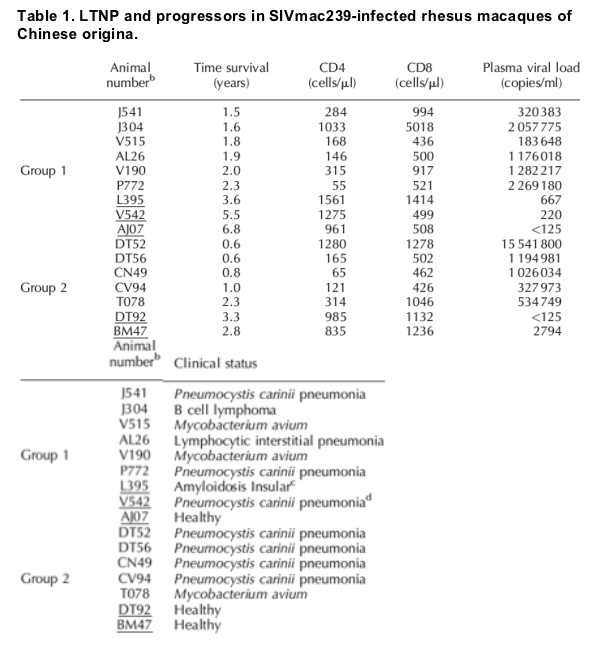
aTwo groups were studied, both were inoculated intravenously. Group 1 was inoculated with 100 TCID50 of a molecular clone SIVmac239. Group
2 was inoculated with 1 ml plasma (contained 2 106 copies of SIVmac239) from P772. Numbers of CD4, CD8 and plasma viral load shown were at the time of survival.
bUnderlined animal numbers are LTNP.
cNon-AIDS related disease.
dA LTNP for 5.4 years, developed AIDS in 35 days after in vivo CD8 cell depletion experiment.
A second clinical outcome, consistent with long term nonprogression, was observed in three animals (Table 1). These three consistently controlled plasma viremia below 1000 copies/ml by 6 months of infection and have survived up to 6 years without disease.
Seven additional Ch Rh (Group 2) were inoculated with 1 ml plasma (containing 2 X 106 copies of SIV) from one animal P772 in Group 1 that had progressed to AIDS. This macaque had the highest plasma viral load at the time of developing AIDS, and it had relatively low PVL during weeks 10-20 postinfection which then increased until the development of AIDS. The purpose of SIV passage was to adapt SIVmac to Ch Rh and increase the pathogenicity of the virus in this subspecies. Again, all animals had high levels of viremia in primary infection but two suppressed PVL and became LTNP (Table 1). In total 31% (5/16) of the ChRh inoculated with highly virulent SIVmac239 became LTNP. Based on these observations and similar to human LTNP [4], macaque LTNP are defined as animals that maintain persistent control of plasma viremia to < 750 copies/ml by 36 weeks postinfection and are clinically healthy.
Comparison of dynamics of viral loads and T cells in blood in LTNP and progressors
Plasma viral load is the most important parameter for disease progression in SIV and HIV infections [10]. To examine differences in the magnitude and dynamics of plasma viremia between LTNP and progressors, we compared viral loads throughout infection in both cohorts. Acute peak PVL were the same in timing and magnitude (Fig. 1a,b). From week 2 to week 4, the median PVL of LTNP were 2-4 times lower than those of progressors, but this was not statistically significant (P > 0.05). Thereafter, the median PVL of the two groups differed significantly at each time point (P < 0.001). Progressors J541 and P772 had relatively low PVL between weeks 10 and 20 postinfection but increased to 105-106 copies/ml thereafter and AIDS developed at 18 and 27 months respectively. Other progressors had high levels of viremia ranging from 104 to 107 copies/ml (Fig. 1a). LTNP persistently controlled PVL from < 103 (1,000) copies/ml to undetectable levels starting approximately 8 weeks after infection (Fig. 1b).
Fig. 1. Sequential plasma viral loads (PVL) and CD4, CD8 T-cell counts (mean ± SD) of SIVmac239-infected rhesus macaques of Chinese origin. There were no significant differences in the peak viral load (week 2) between progressors (a) and LTNP (b) (P > 0.05). The set point viral loads in progressors ranged from 104 to 107 copies/ml in 9 of the 11 animals, the other two progressors (J541 and P772) maintained viral loads ≦ 1000 copies/ml for 10 weeks but not longer. LTNP had persistent PVL of < 1000 copies/ml by 8 weeks post infection except for LTNP AJ07 which fluctuated at higher levels at two time points. These low PVL were maintained for up to 6 years (data not shown). LTNP had higher mean levels of CD4 T-cell counts but they were not statistically different (c) (P > 0.05). The mean levels of CD8 T cells were also not significantly different (d).
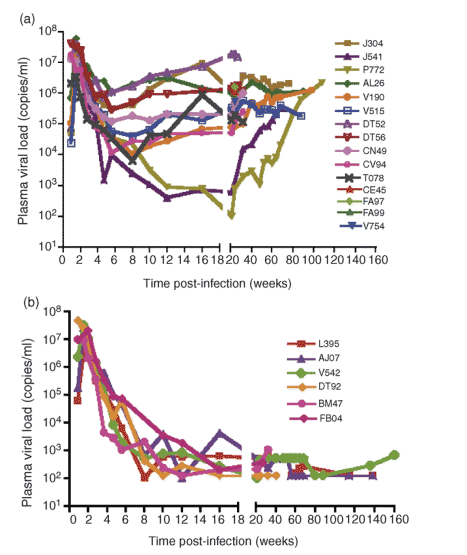
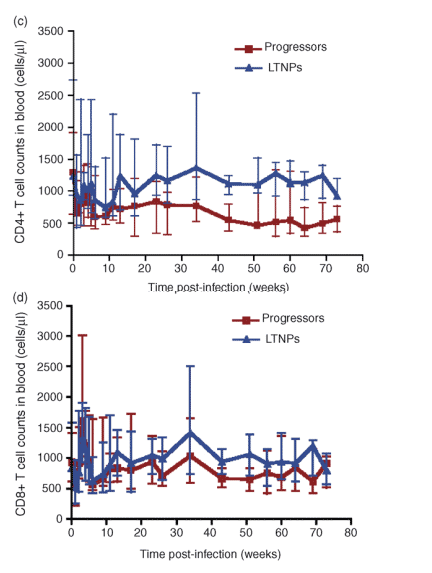
Depletion of mucosal CD4 T cells in GALT in LTNPs and progressors
To determine if SIV infected LTNP have early, rapid and massive depletion of CD4 target cells in the intestine, we performed a longitudinal study on 12 Ch Rh infected with SIVmac239 using two different sampling schedules (Fig. 2a,b) to obtain a broader spectrum of changes of CD4 T cells. Of the 12 animals tested, four became LTNP. The percentage of intestinal CD4 T cells was not significantly different between LTNP and progressors before infection or during the acute phase ≦ 15 weeks postinfection when variable degrees of CD4 T-cell depletion were observed in all animals. Therefore, the degree of total CD4 T-cell loss in GALT in the acute stage neither predicted nor determined disease progression because of the possibly high and variable contribution of naive CD4 T cells in different individuals.
Fig. 2. Dynamics of mucosal CD3/CD4 T cells and restoration of memory CD4/CCR5 T cells in GALT during SIV infection in rhesus macaques of Chinese origin. To obtain a broad view of the changes in CD4 cells during SIV infection, two separate studies were performed with different sampling time points. Five of nine animals in Group 1 were studied in GALT. LTNP are in shades of blue and all progressors are in shades of red. Cells were gated first on lymphocytes, then on CD3 T lymphocytes. AJ07, V542 (blue in panels a and d) and DT92, BM47 (blue in panels b and e) were LTNP in Groups 1 and 2 respectively. The remaining macaques were AIDS progressors (red in all panels). An index of memory CD4/CCR5 T cells (target cells) was defined as the %CD4 in CD3 T lymphocytes X (%CCR5+CD45RA- X 100). An example of the data for the index calculations is shown in (c). Restoration of target cells was the degree to which these cells were restored when compared to day 0 levels. *No data available for AL26, V190 and V515 due to death with AIDS. **No data for progressors due to death with AIDS.
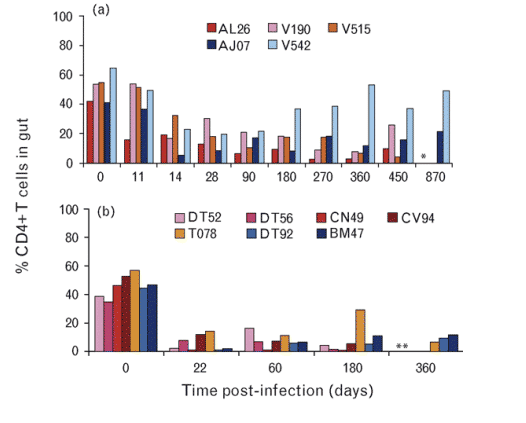
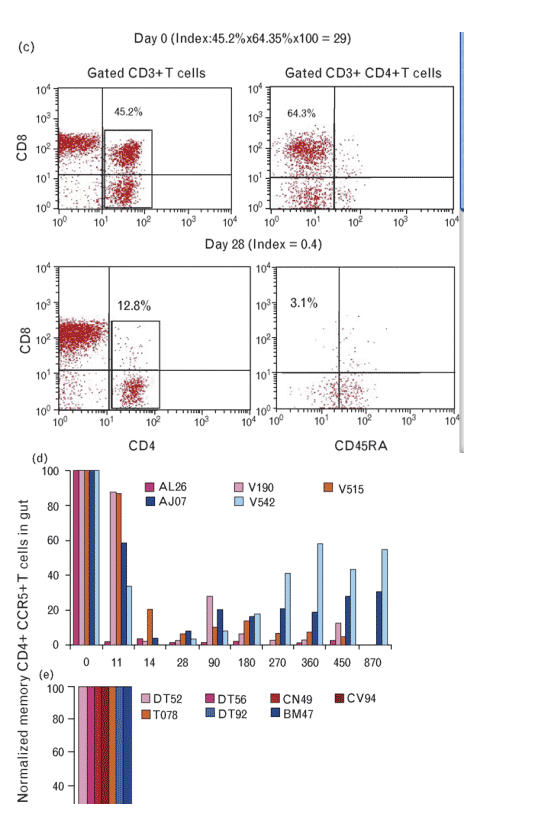
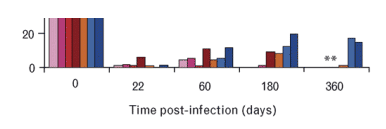
Depletion of intestinal memory CD4 CCR5 T cells in LTNP and progressors in acute SIV infection
As depletion of CD4 T cells in the gut in LTNP was not statistically significant compared to that of progressors, we further studied memory CD4 CCR5 T cells. Because absolute numbers of memory CD4 T cells cannot be directly measured by flow cytometry, we used a previously defined index (%CD4 in CD3 T lymphocytes X (%CCR5+CD45RA- X 100) [6] to 'semi-quantify' numbers of optimal viral 'target cells' (memory CD4/CCR5 T cells) (Fig. 2c). This index reflects both the total CD4 T cells as well as the percentage of those cells expressing CCR5 and a memory phenotype.
Before infection, the index in the LTNP and progressors groups was not significantly different (P = 0.05) although LTNP had higher indices. To compare the dynamics of these cells, the ability to restore memory CD4/CCR5 cells was defined as the degree to which these cells were restored, compared to baseline index levels. Profound depletion of these target cells were observed in both LTNP and progressors from day 14 to day 28 after infection (Fig. 2d,e).
Restoration of intestinal memory CD4/CCR5 T cells in LTNP after 6 months of infection
Observation of the dynamics of target cells showed that LTNP gradually restored memory CD4/CCR5 T cells through the course of SIV infection (Fig. 2d,e). Beginning from day 60 after infection, various degrees of target cell restoration occurred in LTNP and in some progressors, but only LTNP had the ability to consistently increase the level of target cell restoration. By 180 days postinfection, memory CD4/CCR5 T cells in LTNP were higher than in each progressor, and all LTNP restored at least 15% of baseline levels. By day 360, LTNP AJ07 had restored 18.3% and V542 recovered 57.6% of intestinal memory CD4/CCR5 T cells; AJ07 continued to increase to 30% and V542 maintained a similar level (54.7%) by day 870. Even though progressor V190 had the highest level (27.4%) of target cells at day 90 in group 1, it failed to maintain these levels, and developed AIDS at 24.5 months postinfection (Table 1). All other progressors failed to restore memory CD4/CCR5 T cells to a level sufficient to resist progress to disease. In contrast, restoration of intestinal memory CD4/CCR5 T cells correlated with suppression of SIV replication and a positive clinical outcome.
CD8 T-cell depletion in 2 LTNP
To evaluate the role of CD8 T cells in controlling virus replication and maintaining intestinal CD4 T-cell numbers in LTNP, we performed an in vivo depletion of CD8 T cells as described previously [11]. The two animals that were chosen (AJ07 and V542) had survived the longest. Before CD8 depletion, virus was undetectable (< 125 copies/ml) and both were healthy. They received three treatments of anti-CD8 monoclonal antibody cM-T807 at days 0, 3 and 7 postfirst treatment. This antibody effectively mediates transient complete depletion of CD8 T lymphocytes in rhesus [7-9]. Peripheral blood CD8 T cells were depleted by days 3 to 13 after cM-T807 treatment (Fig. 3a). The recovery of circulating CD8 T cells was slow but AJ07 had a faster rebound week 3 and 4 posttreatment than V542. Interestingly, CD8 T cells in lymph node and GALT were also depleted at day 7-13 during treatment (Fig. 3c,d).
Fig. 3. In vivo CD8 depletion in two LTNP. Plasma viral loads and percentages of CD4 and CD8 T cells in peripheral blood after anti-CD8 antibody treatment of LTNP AJ07 (a, upper panel) and V542 (a, middle panel). Both animals had a transient viremia after CD8 antibody treatment but the viremia was rapidly reduced to undetectable or < 1000 copies/ml. CD8 T cells in AJ07 recovered 3 months after CD8 antibody treatment. Absolute CD4 and CD8 T-cell counts in peripheral blood (b). Dynamics of CD8 T cells in blood, lymph nodes and gut at day 0, day 9 and day 35 during anti-CD8 antibody treatment in LTNP AJ07 (c) and V542 (d). The cells were gated on lymphocytes and CD3 T cells. CD8 T cells were depleted in all three compartments on day 9. AJ07 had full recovery of CD8 T cells in gut, in contrast V542 had less recovery compared to the level before anti-CD8 antibody treatment.
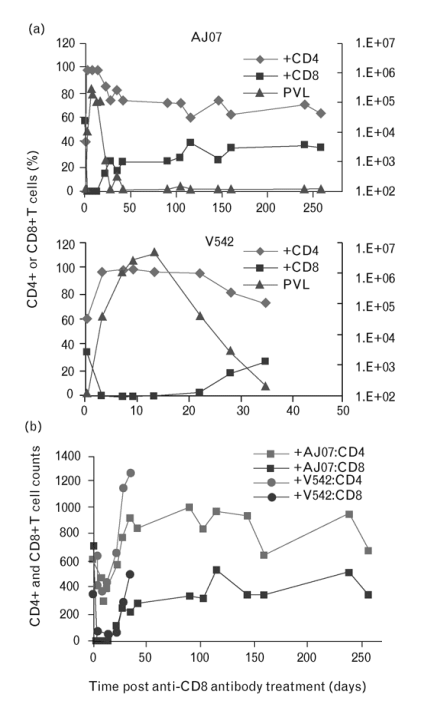
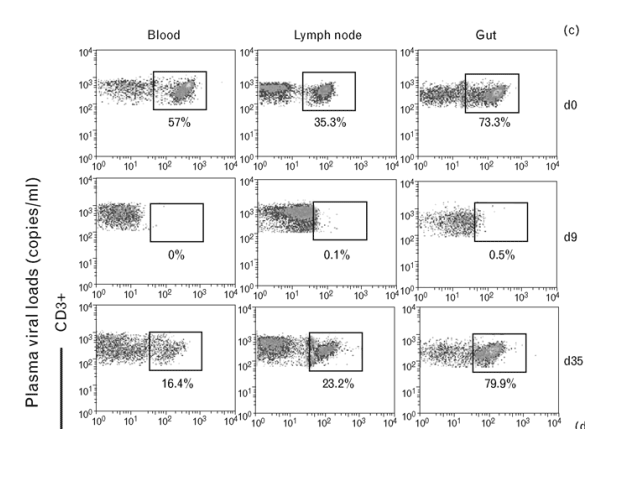
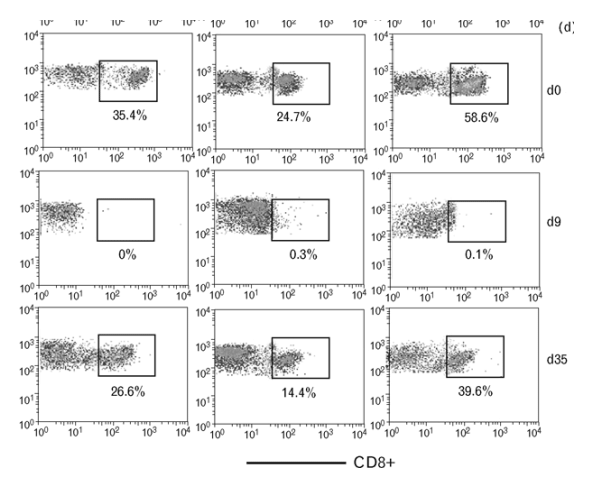
During CD8 T-cell depletion, PVL rebounded and reached a transient peak of 274 169 copies/ml in AJ07 at day 7, and 5 344 700 copies/ml in V542 at day 13. This observation is consistent with other studies [7-9,11-13]. Interestingly, the transient peak viremia in both animals was one-tenth that of their primary infection (5 173 400 copies/ml in AJ07 and 27 864 300 copies/ml in V542) suggesting that factors other than CD8 T cells were involved in controlling this second peak. After peak viremia, PVL quickly dropped to undetectable levels in AJ07 at day 28, and following a small increase (323 copies/ml) at day 35, remained undetectable for 7 months. V542 had 3.0 X 103 copies/ml at day 28 and dropped to 220 copies/ml by day 35, however, this animal developed AIDS and was euthanized at day 35.
Throughout the period of CD8 depletion, the percentage of CD4 T cells in blood did not vary significantly in either monkey (Fig. 3a). However CD4 T-cell counts were reduced at days 7-9 followed by a full recovery by day 22 in both macaques (Fig. 3b). This observation is consistent with another study [12], and this partial reduction of CD4 cells may have been due to cellular activation mediated by anti-CD8 antibody or the effects of massive cell loss and may not have been caused by SIV replication [12]. It is noteworthy that by day 22 posttreatment both animals had higher CD4 cell counts compared to before treatment, which would be consistent with increased activation/replication of CD4 T cells. AJ07 still had a similar level of CD4 cells at 8 months of cM-T807 treatment, further indicating accelerated CD4 T-cell turnover.
We then compared memory CD4/CCR5 T cells in blood and gut (Fig. 4). In blood, both animals showed a rapid and severe loss of target cells during CD8 cell depletion. However, V542 rapidly recovered these cells in blood at day 35. In contrast, in the gut both animals had partial depletion and then a rebound to different levels. However, by day 35, AJ07 had 32% of memory CD4/CCR5 T cells which was twice the level before anti-CD8 treatment (16%), while V542 rebounded to 15% which was slightly lower than before anti-CD8 treatment (19%). Therefore, AJ07 had much greater restoration of mucosal CD4/CCR5 T cells compared to V542 (Fig. 4). The more rapid intestinal memory CD4/CCR5 T cell restoration in AJ07 may have played a role in clearing plasma viremia. AJ07 remains healthy, whereas V542 was euthanised because of AIDS at day 35 post anti-CD8 treatment.
Fig. 4. Partial depletion and rebound of memory CD4/CCR5 cells in blood and intestine during anti-CD8 antibody cM-T807 treatment in LTNP AJ07 and V542. Memory target cells, CD45RA-/CCR5+ CD4 T cells, were gated on total CD4/CD3 T lymphocytes. AJ07 had high restoration of memory CD4/CCR5 T-cells in gut; V542 restored target cells in the peripheral blood but has less restoration in gut.
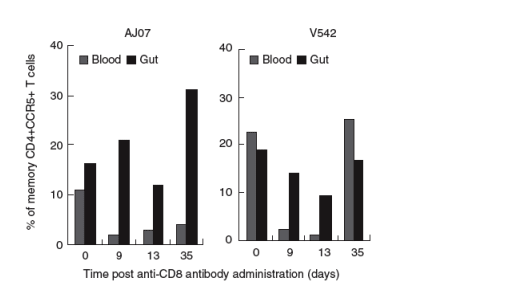
Materials and methods
Animals, infection and tissue sampling
All animals were housed at the Tulane National Primate Research Center (TNPRC). They were sero-negative for SIV, simian D retrovirus and simian T-cell leukemia virus. Nine animals were intravenously infected with 100 TCID50 of molecularly cloned SIVmac239, seven were infected with plasma derived from SIVmac239-infected ChRh with AIDS. All animal protocols were approved by the Institutional Animal Care and Use Committee. Blood, lymph node and intestinal tissue samples were collected at various time points. Peripheral blood mononuclear cells (PBMC) and lymphocytes from jejunal and lymph node biopsy samples were isolated as previously described [6]. Plasma viral load (PVL) was determined by bDNA assay, the detection limit was 125 copies/ml [6].
Antibodies and flow cytometry
EDTA blood was stained using CD3-Pacific blue, CD8-PE-Texas red, CD4-APC, CD45RA-FITC, CD95-PE-Cy5, CCR5-PE for 30 min at 4��C in the dark, then washed twice with phosphate-buffered saline (PBS) containing 2% fetal calf serum (FCS). Red blood cells were lysed and labeled cells were fixed with 1% paraformaldehyde. Samples were analyzed using a FACSAria flow cytometer (Becton-Dickinson, San Jose, California, USA). At least one million total events were collected. Memory CD4 T cells were discriminated by CD45RA and CD95 expression.
CD8 T lymphocyte depletion
Animals were anesthetized with 10 mg/kg ketamine hydrochloride, then received three doses of the mouse/human chimeric antihuman CD8 monoclonal antibody cM-T807 (provided by Centocor Inc.), with 10 mg/kg given subcutaneously on day 0 and 5 mg/kg doses administered intravenously on days 3 and 7 [7-9].
Statistical analyses TOP
The analysis of two-way ANOVA test was used for comparison of plasma SIV RNA levels, CD4, CD8 T-cell counts between LTNP and progressors at each measured time points. Mann-Whitney test was used for the percentage of memory CD4/CCR5 T cells for the two groups of LTNP and progressors before SIV infection. Values are expressed as median ± interquartile range. All reported P values were two-sided at the 0.05 significance level using the Graph Pad Prism 4.0 software statistical program.
References
1. Mattapallil JJ, Douek DC, Hill B, Nishimura Y, Martin M, Roederer M. Massive infection and loss of memory CD4+ T cells in multiple tissues during acute SIV infection. Nature 2005; 434:1093-1097.
2. Brenchley JM, Schacker TW, Ruff LE, Price DA, Taylor JH, Beilman GJ, et al. CD4+ T cell depletion during all stages of HIV disease occurs predominantly in the gastrointestinal tract. J Exp Med 2004; 200:749-759.
3. Mehandru S, Poles MA, Tenner-Racz K, Horowitz A, Hurley A, Hogan C, et al. Primary HIV-1 infection is associated with preferential depletion of CD4+ T lymphocytes from effector sites in the gastrointestinal tract. J Exp Med 2004; 200:761-770.
4. Sankaran S, Guadalupe M, Reay E, George MD, Flamm J, Prindiville T, et al. Gut mucosal T cell responses and gene expression correlate with protection against disease in long-term HIV-1-infected nonprogressors. Proc Natl Acad Sci USA 2005; 102:9860-9865.
5. O'Connor DH, Mothe BR, Weinfurter JT, Fuenger S, Rehrauer WM, Jing P, et al. Major histocompatibility complex class I alleles associated with slow simian immunodeficiency virus disease progression bind epitopes recognized by dominant acute-phase cytotoxic-T-lymphocyte responses. J Virol 2003; 77:9029-9040.
6. Ling B, Veazey RS, Luckay A, Penedo C, Xu K, Lifson JD, et al. SIV(mac) pathogenesis in rhesus macaques of Chinese and Indian origin compared with primary HIV infections in humans. AIDS 2002; 16:1489-1496.
7. Schmitz JE, Kuroda MJ, Santra S, Sasseville VG, Simon MA, Lifton MA, et al. Control of viremia in simian immunodeficiency virus infection by CD8+ lymphocytes. Science 1999; 283:857-860.
8. Schmitz JE, Simon MA, Kuroda MJ, Lifton MA, Ollert MW, Vogel CW, et al. A nonhuman primate model for the selective elimination of CD8+ lymphocytes using a mouse-human chimeric monoclonal antibody. Am J Pathol 1999; 154:1923-1932.
9. Schmitz JE, Johnson RP, McClure HM, Manson KH, Wyand MS, Kuroda MJ, et al. Effect of CD8+ lymphocyte depletion on virus containment after simian immunodeficiency virus SIVmac251 challenge of live attenuated SIVmac239delta3-vaccinated rhesus macaques. J Virol 2005; 79:8131-8141.
10. Lifson JD, Nowak MA, Goldstein S, Rossio JL, Kinter A, Vasquez G, et al. The extent of early viral replication is a critical determinant of the natural history of simian immunodeficiency virus infection. J Virol 1997; 71:9508-9514.
11. Matano T, Shibata R, Siemon C, Connors M, Lane HC, Martin MA. Administration of an anti-CD8 monoclonal antibody interferes with the clearance of chimeric simian/human immunodeficiency virus during primary infections of rhesus macaques. J Virol 1998; 72:164-169.
12. Jin X, Bauer DE, Tuttleton SE, Lewin S, Gettie A, Blanchard J, et al. Dramatic rise in plasma viremia after CD8(+) T cell depletion in simian immunodeficiency virus-infected macaques. J Exp Med 1999; 189:991-998.
13. Metzner KJ, Jin X, Lee FV, Gettie A, Bauer DE, Di Mascio M, et al. Effects of in vivo CD8(+) T cell depletion on virus replication in rhesus macaques immunized with a live, attenuated simian immunodeficiency virus vaccine. J Exp Med 2000; 191:1921-1931.
14. Mellors JW. Viral-load tests provide valuable answers. Sci Am 1998; 279:90-93.
15. Staprans SI, Dailey PJ, Rosenthal A, Horton C, Grant RM, Lerche N, et al. Simian immunodeficiency virus disease course is predicted by the extent of virus replication during primary infection. J Virol 1999; 73:4829-4839.
16. Smith SM, Holland B, Russo C, Dailey PJ, Marx PA, Connor RI. Retrospective analysis of viral load and SIV antibody responses in rhesus macaques infected with pathogenic SIV: predictive value for disease progression. AIDS Res Hum Retroviruses 1999; 15:1691-1701.
17. George MD, Reay E, Sankaran S, Dandekar S. Early antiretroviral therapy for simian immunodeficiency virus infection leads to mucosal CD4+ T-cell restoration and enhanced gene expression regulating mucosal repair and regeneration. J Virol 2005; 79:2709-2719.
18. Chun TW, Nickle DC, Justement JS, Large D, Semerjian A, Curlin ME, et al. HIV-infected individuals receiving effective antiviral therapy for extended periods of time continually replenish their viral reservoir. J Clin Invest 2005; 115:3250-3255.
19. Siliciano JD, Siliciano RF. A long-term latent reservoir for HIV-1: discovery and clinical implications. J Antimicrob Chemother 2004; 54:6-9.
20. Ho J, Moir S, Kulik L, Malaspina A, Donoghue ET, Miller NJ, et al. Role for CD21 in the establishment of an extracellular HIV reservoir in lymphoid tissues. J Immunol 2007; 178:6968-6974.
21. Mehandru S, Poles MA, Tenner-Racz K, Jean-Pierre P, Manuelli V, Lopez P, et al. Lack of mucosal immune reconstitution during prolonged treatment of acute and early HIV-1 infection. PLoS Med 2006; 3:e484.
22. Guadalupe M, Sankaran S, George MD, Reay E, Verhoeven D, Shacklett BL, et al. Viral suppression and immune restoration in the gastrointestinal mucosa of human immunodeficiency virus type 1-infected patients initiating therapy during primary or chronic infection. J Virol 2006; 80:8236-8247.
23. Boyer JD, Kumar S, Robinson T, Parkinson R, Wu L, Lewis M, Weiner DB. Initiation of antiretroviral therapy during chronic SIV infection leads to rapid reduction in viral loads and the level of T-cell immune response. J Med Primatol 2006; 35:202-209.
24. Churchill MJ, Rhodes DI, Learmont JC, Sullivan JS, Wesselingh SL, Cooke IR, et al. Longitudinal analysis of human immunodeficiency virus type 1 nef/long terminal repeat sequences in a cohort of long-term survivors infected from a single source. J Virol 2006; 80:1047-1052.
25. Mologni D, Citterio P, Menzaghi B, Poma BZ, Riva C, Broggini V, et al. Vpr and HIV-1 disease progression: R77Q mutation is associated with long-term control of HIV-1 infection in different groups of patients. AIDS 2006; 20:567-574.
26. Moss WJ, Ryon JJ, Monze M, Cutts F, Quinn TC, Griffin DE. Suppression of human immunodeficiency virus replication during acute measles. J Infect Dis 2002; 185:1035-1042.
27. Stapleton JT. GB virus type C/Hepatitis G virus. Semin Liver Dis 2003; 23:137-148.
28. Garcia M, Yu XF, Griffin DE, Moss WJ. In vitro suppression of human immunodeficiency virus type 1 replication by measles virus. J Virol 2005; 79:9197-9205.
29. Kannangara S, DeSimone JA, Pomerantz RJ. Attenuation of HIV-1 infection by other microbial agents. J Infect Dis 2005; 192:1003-1009.
30. Turci M, Pilotti E, Ronzi P, Magnani G, Boschini A, Parisi SG, et al. Coinfection with HIV-1 and human T-cell lymphotropic virus type II in intravenous drug users is associated with delayed progression to AIDS. J Acquir Immune Defic Syndr 2006; 41:100-106.
31. McMichael AJ, Rowland-Jones SL. Cellular immune responses to HIV. Nature 2001; 410:980-987.
32. Koup RA, Safrit JT, Cao Y, Andrews CA, McLeod G, Borkowsky W, et al. Temporal association of cellular immune responses with the initial control of viremia in primary human immunodeficiency virus type 1 syndrome. J Virol 1994; 68:4650-4655.
33. Kuroda MJ, Schmitz JE, Charini WA, Nickerson CE, Lifton MA, Lord CI, et al. Emergence of CTL coincides with clearance of virus during primary simian immunodeficiency virus infection in rhesus monkeys. J Immunol 1999; 162:5127-5133.
34. Davenport MP, Zhang L, Bagchi A, Fridman A, Fu TM, Schleif W, et al. High-potency human immunodeficiency virus vaccination leads to delayed and reduced CD8+ T-cell expansion but improved virus control. J Virol 2005; 79:10059-10062.
|
|
| |
| |
|
|
|